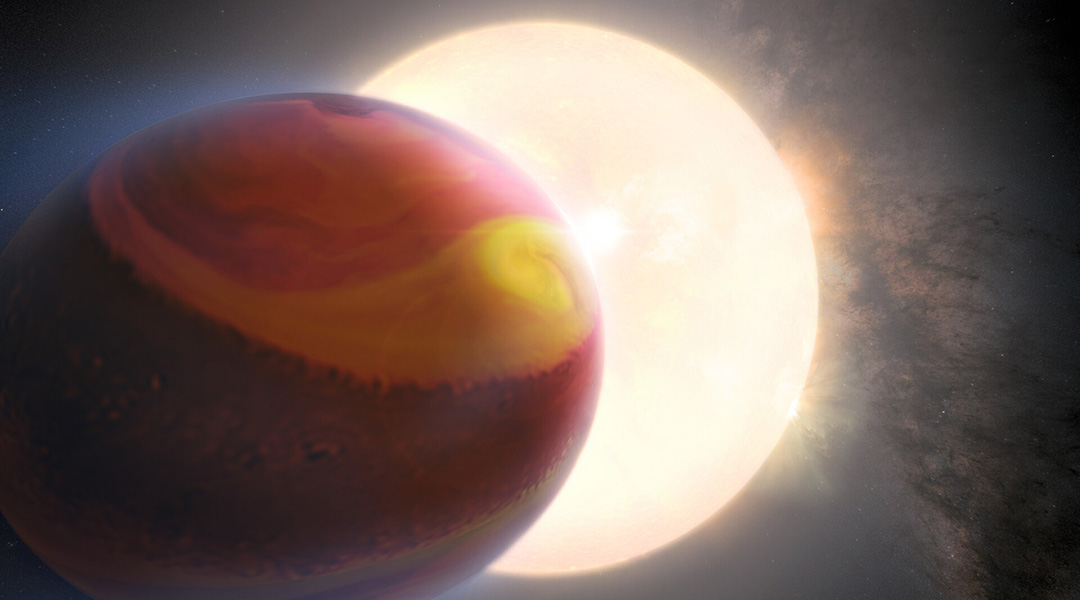Astronomers have taken a three-year-long view of an extreme heavy metal exoplanet called WASP-121b using the Hubble Space Telescope, enabling them to reconstruct its changing atmosphere and weather in a way that has never been done for a planet outside the solar system before. This revealed this violent and turbulent world is even more chaotic than scientists initially suspected.
WASP-121b, a planet that is 1.75 times the size of Jupiter and orbiting so close to its host star that it completes an orbit in just 30 hours, which is one of the shortest orbits ever seen by astronomers.
This proximity means that WASP-121b, located around 880 light-years from Earth is tidally locked, meaning one hemisphere of this planet (its “dayside”) permanently faces its star, while the other (the nightside) perpetually faces out into space.
As a result of the constant bombardment of radiation, the dayside temperatures of WASP-121b –which, because of its size and proximity to its star, is classified as a “hot Jupiter” exoplanet — soar up as high as 4,700 degrees Celsius, vaporizing iron and aluminum.
The intense heating of WASP-121b also generates powerful 11,000 miles per hour winds that blow vaporized metals from WASP-121b’s radiation roasted dayside to the planet’s cooler nightside, which still has a fearsome temperature of 730 degrees Celsius. Here these metal clouds mix with minerals, cooling, and falling as rains of iron, rubies, and sapphires.
Three years on WASP-121b
Isolated observations alone, even from instruments as powerful as Hubble, aren’t enough to see how atmospheres change on planets as far away as WASP-121b. Fortunately, Hubble has been active since 1990, meaning its archival data is bursting with multiple observations of the same celestial bodies.
The team, including principal investigator and European Space Agency research fellow Quentin Changeat, took infrared observations made using the Hubble Wide Field Camera 3 (WFC 3) of the hot Jupiter collected in 2016, 2018, and 2019. These showed the planet as it passed in front of and moved behind its star, known as WASP-121.
The way this Hubble data was processed previously didn’t allow the three sets of data from each year to be directly compared, but the researchers repolished these observations in the same way so they could effectively be compared, constituting a developing picture of this world’s atmosphere.
“This is one of the most extensive studies of weather patterns on an exoplanet,” Changeat told Advanced Science News. “We utilized repeated observations from Hubble to constrain the properties of the planet’s atmosphere and its variability.”
After collecting their Hubble data, the team then applied the same data processing method to each observation, changing infrared to visible colors for example, regardless of how this data may have been processed by other teams in the past to ensure they were consistent. This allowed them to characterize the changing atmosphere, chemistry, temperature, and clouds of WASP-121 b at different times. In addition, the scientists saw that the hot spot of WASP-121 b is shifting and that the planet is seeing the repeated generation of multiple massive cyclones.
“Those supercomputer models helped discover a new storm-generation mechanism where multiple cyclones are repeatedly generated and destroyed,” Changeat said. “This pattern is generated by the high irradiation of the star, which deposits significant energy deep on the day side of the planet.”
Shocking planetary weather
Even though the team was well aware how turbulent and different to Earth that this planetis, the extent of the chaos they witnessed shocked them.
“We were surprised by how extreme the conditions on ultra-hot Jupiters can be,” Changeat added. “While storms and other extreme phenomena are common on the Earth and solar system planets, it is much more impressive on ultra-hot Jupiters where storms the size of the Earth can easily be generated.”
The ESA scientist explained that the team now intends to continue examining repeated observations of WASP-121b, factoring in data from the James Webb Space Telescope (JWST) and the forthcoming Atmospheric Remote-sensing Infrared Exoplanet Large-survey (Ariel) space telescope set to launch in 2029. This should help them better understand planetary weather across a diverse range of exoplanets, potentially leading to the discovery of new physical processes.
“This research reflects the turning point we are currently experiencing in the field of exoplanets. In the past decade, we were limited to understanding the general properties of exoplanets, like their size or their mass, but we are now entering a new era where data and models allow us to ask more fundamental questions,” Changeat concluded.
“Thanks to the extensive library of data from Hubble and the growing collection of observations by JWST, we are now able to answer precise questions about exoplanets, their composition, their formation, or, like in our research, their weather.”
Reference: Q. Changeat, Is the atmosphere of the ultra-hot Jupiter WASP-121b variable?, arXiv, [2024], [arXiv:2401.01465]; accepted for publication
Feature image: An illustration of the scorching hot exoplanet WASP 121 b as it transits its parent star. Credit: NASA, ESA, Q. Changeat et al., M. Zamani (ESA/Hubble)

















